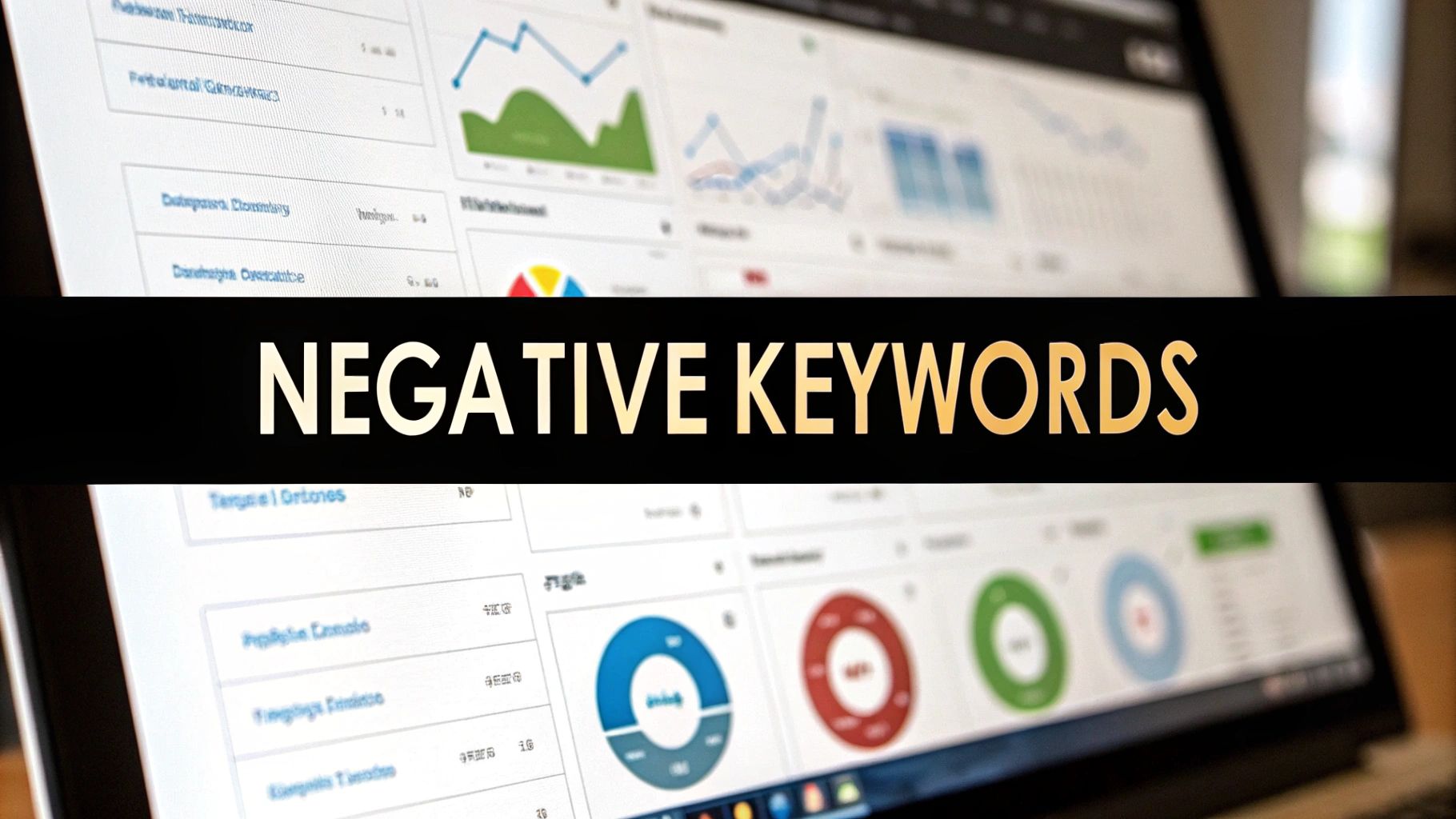October 19, 2025
Your 2025 General Negative Keyword List: 8 Categories


Running Google Ads can feel like you're trying to fill a leaky bucket. You pour money in, but a steady stream of junk clicks from job seekers, bargain hunters, and tire-kickers drains your budget before real customers can convert. The fix? A rock-solid general negative keyword list. It's the simplest yet most powerful tool you have to plug those leaks, improve your Quality Score, and make sure your ads are only shown to people who are actually ready to buy.
But where do you even start? Right here. This isn't just another generic post; we've built the ultimate cheat sheet with 8 essential categories of negative keywords every PPC manager needs. Think of this as your go-to resource for making your campaigns instantly more profitable. To truly stop burning cash in your marketing efforts, implementing a comprehensive negative keyword strategy is non-negotiable. For broader strategies on improving your ad spend efficiency, you can also explore these proven ways to lower customer acquisition costs.
This guide will give you the exact terms to exclude—from informational queries like "how to" and "tutorial" to low-value modifiers like "free" and "cheap"—so you can stop wasting money and start focusing on high-intent traffic. Let's dive in and start saving some serious cash.
1. Job-Related Keywords (free, jobs, careers, hiring)
Unless you’re actively running a recruitment campaign, clicks from job seekers are a major budget drain. These searchers have zero intent to buy your products or services; they're looking for an application form, not a checkout page. Adding job-related terms to your general negative keyword list is one of the quickest and most effective ways to filter out this irrelevant traffic and protect your ad spend.
This category includes all the usual suspects like 'jobs', 'careers', 'hiring', and 'employment'. Think about it: a user searching for "Acme Co. jobs" wants to work for you, not buy from you. Allowing your product ad to show up is just a recipe for wasted clicks and skewed conversion data.

Why This Category is Essential
Job-related searches represent a completely different user intent. Someone searching for "Microsoft careers" isn't in the market for a new Surface Pro. By excluding these terms, you ensure your ads are only served to users with commercial intent, leading to a higher ROAS (Return on Ad Spend) and more meaningful engagement. It's a foundational step in cleaning up any PPC account.
Key Insight: Wasted clicks from job seekers don't just cost money; they also damage your Quality Score. Google sees low engagement and high bounce rates as signals that your ad is irrelevant to the search query, which can increase your cost-per-click over time.
Actionable Tips for Implementation
- Go Beyond the Obvious: Start with the basics like
jobs,hiring, andcareers. But also include related terms likeresume,application,vacancy,internship, andsalary. - Use Phrase Match: Add these as phrase match negative keywords (e.g., "hiring manager," "job application"). This provides a good balance, blocking irrelevant searches without being overly restrictive.
- Create a Separate List: If you ever run hiring campaigns, create a separate campaign for them. You can then apply your job-related negative list to all your non-recruitment campaigns, keeping the targeting clean and separate.
2. Free and Cheap Keywords (free, cheap, discount codes, coupon)
Unless your business model revolves around offering freebies or deep discounts, clicks from bargain hunters can be a massive waste of ad spend. These users are laser-focused on finding the lowest possible price—or paying nothing at all. Adding terms like 'free', 'cheap', and 'coupon' to your general negative keyword list is crucial for filtering out traffic that has a low probability of converting on your premium products or standard-priced services.
This category is designed to block searchers whose primary intent is cost-avoidance rather than value-seeking. For instance, a user searching for "Salesforce free CRM" is likely not the target audience for an ad promoting its premium enterprise tiers. Similarly, a luxury brand would never want its ads to appear for "cheap designer handbags." Allowing these ads to show wastes money and attracts the wrong kind of customer.

Why This Category is Essential
Queries containing "free" or "cheap" signal a user intent that is often misaligned with profitability. For businesses selling paid software, premium services, or high-end physical products, these clicks lead to high bounce rates and near-zero conversions. By proactively blocking these terms, you make sure your marketing budget is spent attracting customers who understand and are willing to pay for the value you provide, directly improving your return on ad spend (ROAS).
Key Insight: Software and digital product companies are especially vulnerable. Searchers using modifiers like 'torrent', 'cracked', 'keygen', or 'serial key' have no intention of ever paying. These terms should be on every software company's negative keyword list to prevent budget drain from users seeking pirated versions.
Actionable Tips for Implementation
- Be Specific with Your Exclusions: If you offer a 'free trial' or 'free quote', be sure to add terms like
free downloadorfree accountas negative phrase match keywords, but addtrialandquoteas negative keywords to your exact match negative list. This prevents blocking legitimate lead-generating searches. - Consider Your Brand Positioning: If you sell a premium product, add
cheap,discount,low price, and even misspellings likecheepto your negative list. This protects your brand perception and focuses your budget on qualified buyers. - Segment Your Campaigns: If you run occasional sales, create a separate campaign for that promotion. This allows you to remove negatives like
couponordiscount codefrom just that campaign without compromising the integrity of your evergreen campaigns.
3. Educational Keywords (how to, tutorial, DIY, guide, learn)
Searchers using educational keywords are looking for knowledge, not a "buy now" button. Clicks from users searching for 'how to', 'tutorial', or 'what is' are incredibly valuable for content marketing but can be a serious budget leak in conversion-focused paid search campaigns. These users are in the research or learning phase of their journey, meaning their intent to purchase is low to non-existent at that moment.
Adding these informational terms to your general negative keyword list is a crucial step in separating top-of-funnel research from bottom-of-funnel commercial intent. For example, a home improvement store wants to sell a drill, not pay for clicks from users searching "how to build a deck." Excluding these terms ensures your ad spend is reserved for users actively looking to make a purchase.

Why This Category is Essential
Educational searches signify a user's need for information, not a product. A person searching for "best workout guide" is likely looking for a free PDF or a YouTube video, not to purchase a treadmill right then and there. By filtering out this traffic from your transactional campaigns, you direct your budget toward high-intent queries, which directly improves your conversion rates and ROAS. It's all about meeting the user at the right stage of their journey with the right message.
Key Insight: While you exclude these terms from sales campaigns, this search data is a goldmine for your content strategy. The informational queries you block can become the titles for your next blog post, FAQ section, or YouTube tutorial, attracting organic traffic that you can later nurture into customers.
Actionable Tips for Implementation
- Build a Comprehensive List: Start with core terms like
how to,tutorial,guide,DIY,learn, andtips. Expand it with terms likewhat is,definition,example,resource,training, andcourse. - Segment Your Campaigns: The best practice is to have separate campaigns. One campaign focuses on driving conversions and includes this educational negative list. Another campaign can be designed for brand awareness or lead generation, where you might bid on some of these terms to promote a helpful guide or webinar.
- Leverage for Retargeting: A smart strategy is to allow traffic from some of these informational queries to land on a blog post or guide. You can then add these visitors to a retargeting audience and show them product-focused ads later, once they're more familiar with your brand.
4. Competitor Brand Names and Misspellings
Unless you’re running a specific head-to-head "conquesting" campaign, allowing your ads to show for competitor brand searches is like paying to advertise inside your rival's store. These searchers are already looking for another company, and while you can sometimes win them over, it's often an expensive, uphill battle with low conversion rates. Adding competitor names to your general negative keyword list is a smart defensive move to focus your budget on more qualified traffic.
This strategy involves blocking searches for direct competitor names, their specific product lines, and common misspellings. For instance, if you're HubSpot, you might add 'Salesforce' as a negative in your top-of-funnel campaigns to avoid paying for clicks from users who are already deep in a competitor's funnel. This keeps your ad spend efficient and your campaign data clean.

Why This Category is Essential
Bidding on competitor terms can be a powerful tactic, but it has to be intentional. When it happens by accident in general campaigns, it almost always leads to wasted spend. Your ad will have a lower relevance score for a competitor's brand name, resulting in a poor Quality Score and higher CPCs. By excluding these terms from your everyday campaigns, you protect your budget and make sure your ads are shown to users with a higher, more relevant purchase intent.
Key Insight: Clicks on competitor brand terms are notoriously expensive and have low click-through rates (CTR). Excluding them from your general negative keyword list improves your account's overall health by focusing your budget where it will have the greatest impact and deliver a stronger ROAS.
Actionable Tips for Implementation
- Segment Your Campaigns: The best practice is to have separate campaigns. One for general terms (where competitors are negatives) and a separate, highly-targeted campaign for competitive conquesting if you choose to run one. For a deeper dive, check out our guide on navigating competitor PPC keywords on keywordme.io.
- Be Specific: Use exact and phrase match negatives for competitor names (e.g.,
[coca-cola],"pepsi co"). This prevents you from accidentally blocking broader, relevant searches that might happen to contain a part of a competitor's name. - Think Beyond the Name: Don't just block the company name. Include their flagship product names, subsidiary brands, and common misspellings that searchers might use. Update this list quarterly as the competitive landscape evolves.
5. Wrong Product/Service Type Keywords
Few things waste ad spend faster than paying for clicks from users searching for a product or service you simply don't offer. These searchers might be in the right industry, but they’re looking for the wrong solution. Adding a robust list of adjacent, but incorrect, product or service types to your general negative keyword list is crucial for surgical targeting and protecting your budget.
This category is all about drawing a clear line in the sand. If you're a criminal defense lawyer, you don't want clicks from someone searching for a 'divorce attorney'. Similarly, a company selling high-end WordPress hosting has no business showing ads to users looking for 'Wix' or 'Squarespace'. These clicks aren't just irrelevant; they’re a direct path to a high bounce rate and wasted money, as the user will realize their mistake instantly and leave your site.
Why This Category is Essential
Excluding wrong product or service types ensures your ad budget is laser-focused on potential customers who can actually buy what you sell. It sharpens your campaign's relevance, preventing your ads from being diluted across a sea of loosely related, but ultimately fruitless, searches. This is especially vital in specialized niches where broad industry terms can trigger ads for dozens of distinct, non-competing services.
Key Insight: Regularly reviewing your search query report for these types of keywords is non-negotiable. It often reveals customer misconceptions about your offerings, providing valuable insights you can share with your sales and marketing teams to clarify your messaging across all channels.
Actionable Tips for Implementation
- Brainstorm Your "Don't" List: Before you even launch a campaign, create a list of all the adjacent products and services you don't offer. Think like a customer who may not understand the nuances of your industry. For example, a plumber should exclude
electrician,HVAC, andcarpenter. - Consult Your Sales Team: Ask your sales or customer service team what services people mistakenly call in for. They are on the front lines and have a goldmine of information about common customer confusion.
- Use Phrase and Exact Match: For highly specific but different products (e.g., "Samsung phone case" if you only sell iPhone cases), use phrase or exact match negatives to block them without accidentally excluding broader, relevant terms.
- Include Competitor Platforms: If you offer a specific type of software or platform solution (like WordPress hosting), be sure to add competing platforms (
Shopify,Wix,Squarespace) to your general negative keyword list to filter out users loyal to other ecosystems.
6. Geographic Location Negatives (cities, states, countries you don't serve)
Even with precise location targeting, your ads can still show up for searches that include geographic terms outside your service area. A user in Dallas might search for a "plumber in Miami" out of curiosity or to help a relative, triggering your ad and wasting your budget if you only serve Dallas. Adding geographic negatives to your general negative keyword list is a crucial step to prevent this budget leakage.
This category is essential for any business with a defined service area, from a local restaurant to a national e-commerce store that doesn't ship internationally. If a user's search query includes a city, state, country, or neighborhood you don’t serve, you want to ensure your ad stays hidden. This simple exclusion prevents you from paying for clicks from users you can't actually help.
Why This Category is Essential
Geographic negative keywords act as a secondary defense layer to your campaign's location targeting. While campaign settings control who sees the ad based on their physical location or interest, negative keywords control what searches trigger the ad. By blocking irrelevant location-based queries, you filter out users with mismatched intent, ensuring your ad spend is focused exclusively on potential customers within your operational footprint.
Key Insight: Relying solely on campaign location targeting is a common mistake. A user physically located inside your target area can still search for services outside of it. Negative keywords are the only way to filter out the intent behind the search query itself, not just the user's location.
Actionable Tips for Implementation
- Build a Comprehensive List: Start with the obvious, like major cities and states you don't serve. Then, expand to include surrounding suburbs, counties, and even well-known landmarks outside your area.
- Include Variations: Add both full names and common abbreviations to your list (e.g.,
New York,NYC,New York City). Don't forget common misspellings that users might type. - Think Locally and Globally: If you're a local business, exclude nearby city names and neighborhoods outside your delivery or service radius. If you're a national business that only ships within the US, add a list of all other countries to prevent international clicks.
7. B2B vs B2C Intent Keywords (wholesale, bulk, retail, commercial, residential)
Mixing business and consumer traffic is like trying to sell industrial-grade kitchen equipment to someone looking for a new toaster. The intent is completely different, and serving the wrong ad leads to wasted clicks and poor performance. By adding B2B or B2C intent keywords to your general negative keyword list, you can precisely segment your audience, making sure your budget is spent only on searchers who match your ideal customer profile.
This category is about creating a clear divide. If you're a B2B company selling office furniture in bulk, you don't want clicks from someone searching for a "single desk for home." Conversely, if you sell consumer electronics, queries containing 'wholesale' or 'for resale' are budget drains. Properly using these negatives is fundamental to targeting the right market segment.
Why This Category is Essential
Business and consumer buyers operate on different wavelengths. They have distinct purchasing cycles, price sensitivities, and decision-making criteria. A B2B buyer is focused on ROI and operational efficiency, while a B2C customer prioritizes personal need and value. Excluding terms that attract the wrong audience type makes your campaigns instantly more relevant, improving conversion rates and overall ad account health.
Key Insight: This type of segmentation goes beyond simple keyword targeting. It aligns your entire ad experience, from copy to landing page, with a specific buyer's journey. Failing to separate these audiences results in high bounce rates and sends negative signals to Google about your ad's relevance.
Actionable Tips for Implementation
- Build Opposing Lists: If you're B2B, your negative list should include terms like
consumer,residential,personal use,for home, andretail. If you're B2C, excludewholesale,bulk,commercial,distributor,B2B, andfor business. - Segment Your Campaigns: The best practice is to create separate campaigns for B2B and B2C audiences, even if you serve both. Apply the corresponding negative keyword list to each, creating a clean separation. For more details on this strategy, check out our guide on Google Ads audience targeting.
- Think in Industry Terms: Go beyond generic terms. A B2B restaurant supplier should exclude
home kitchen, while a residential cleaning service should addcommercial buildingandoffice cleaningas negatives to its general negative keyword list.
8. Wrong Intent Modifier Keywords (review, comparison, vs, best, alternative, scam)
Not all traffic is created equal. Clicks from users who are still deep in the research phase can drain your budget without generating sales. These searchers are looking for information to make a decision, not a button to complete one. Adding informational and comparison-based modifiers to your general negative keyword list is a crucial step in targeting users with high commercial intent.
This category includes terms like 'review', 'comparison', 'vs', 'best', and 'alternative'. A user searching "Slack vs Asana" is evaluating options, not ready to sign up for a demo. Allowing your direct-response ad to appear for these queries often leads to expensive clicks, low conversion rates, and a skewed understanding of your campaign performance.
Why This Category is Essential
Wrong intent modifiers represent a user who is in the "consideration" stage of the marketing funnel, not the "conversion" stage. While this traffic can be valuable for top-of-funnel content campaigns, it’s poison for campaigns measured on immediate ROI. By excluding these terms, you focus your ad spend on users who have already decided what they want and are now looking for where to get it, resulting in a higher ROAS and cleaner conversion data.
Key Insight: Targeting users who are still comparing options often means you're paying to educate them, only for them to convert later through a competitor's ad or an organic search. Exclude these terms to let your content marketing do the educating and your PPC ads do the converting.
Actionable Tips for Implementation
- Build a Comprehensive List: Start with core terms like
review,comparison,vs,alternative, andscam. Expand this to include variations likeratings,top 10,legit,pros and cons, andor(e.g., "iPhone or Samsung"). - Segment Your Campaigns: Don't block this traffic entirely. Create separate, top-of-funnel campaigns with content-driven landing pages (like a comparison guide) to capture these users. Apply this negative list only to your bottom-funnel, conversion-focused campaigns.
- Be Strategic with "Best": Be careful with the word
best. While "best project management software" is informational, a search for "best price for Nike Air Max" shows strong purchase intent. Consider addingbestas a negative keyword but then use negative keyword exceptions for queries that include transactional terms likepriceordeal.
Negative Keyword Categories Comparison
Automate Your Negatives and Watch Your ROI Soar
Whew, that was a lot to cover! From weeding out job seekers and bargain hunters to steering clear of competitor searches and educational queries, you now have a powerful toolkit at your disposal. This general negative keyword list, broken down into eight core categories, is your secret weapon for instantly improving campaign performance. By applying these lists, you’re not just saving a few cents here and there; you’re fundamentally shifting your budget away from wasted clicks and toward high-intent customers who are ready to convert.
The biggest takeaway here is that negative keywords aren't a "set it and forget it" task. They are a living, breathing part of your PPC strategy. The lists we've provided are a fantastic starting point, a launchpad to protect your budget from the most common sources of irrelevant traffic. But the real magic happens when you make this process a consistent habit.
Turning Knowledge into Actionable ROI
Your next steps are clear:
- Implement the Basics: Take the lists from this article and add them to your shared negative keyword lists in Google Ads. Apply them at the campaign or account level to get immediate protection.
- Schedule Regular Reviews: Dedicate time each week to dive into your search term reports. This is where you’ll find campaign-specific negative keywords that no generic list could ever predict.
- Embrace Automation: Manually managing this process is a massive time-sink. The true path to scaling your success and maximizing your return on investment lies in automation.
Key Insight: A proactive negative keyword strategy does more than just save money. It improves your Quality Score, increases your click-through rate (CTR), and ultimately sends higher-quality signals to Google, which can lower your overall cost-per-click (CPC).
This principle of strategic automation extends far beyond just keyword management. As you grow, you'll find that streamlining repetitive work is crucial for scaling your marketing efforts. In fact, many successful agencies have found significant value in efficiently automating ad operations tasks and calculating ROI across their entire workflow. By embracing technology to handle the tedious work, you free up your team to focus on what really matters: strategy, creativity, and driving real business growth. A powerful general negative keyword list is just the beginning of this journey.
Ready to put your negative keyword management on autopilot? Instead of spending hours digging through search term reports, let Keywordme do the heavy lifting for you. Our tool automatically finds and suggests negative keywords directly from your campaign data, helping you protect your ad spend and improve ROI in a fraction of the time. Start your free trial today and see how simple it is to build a powerful, effective negative keyword strategy.


.svg)